A Report on Macroeconomic Challenges in Canada and North Korea
VerifiedAdded on 2023/06/11
|7
|1783
|388
Report
AI Summary
This report provides a macroeconomic analysis comparing the economies of Canada and North Korea, highlighting their distinct challenges and approaches to economic management. Canada's economy, characterized by a mixed system, grapples with a significant current account deficit, economic slack, and high per capita credit, prompting government interventions like commodity taxes and interest rate regulations. In contrast, North Korea's centrally controlled economy faces issues such as a closed economic system and weak aggregate demand, though the government prioritizes wealth distribution over GDP growth. The report also contrasts how each country copes with the global economy, with Canada being highly vulnerable and actively seeking to diversify its trade relationships, while North Korea remains isolated and unaffected. Desklib offers a range of resources, including past papers and solved assignments, to support students in their academic endeavors.
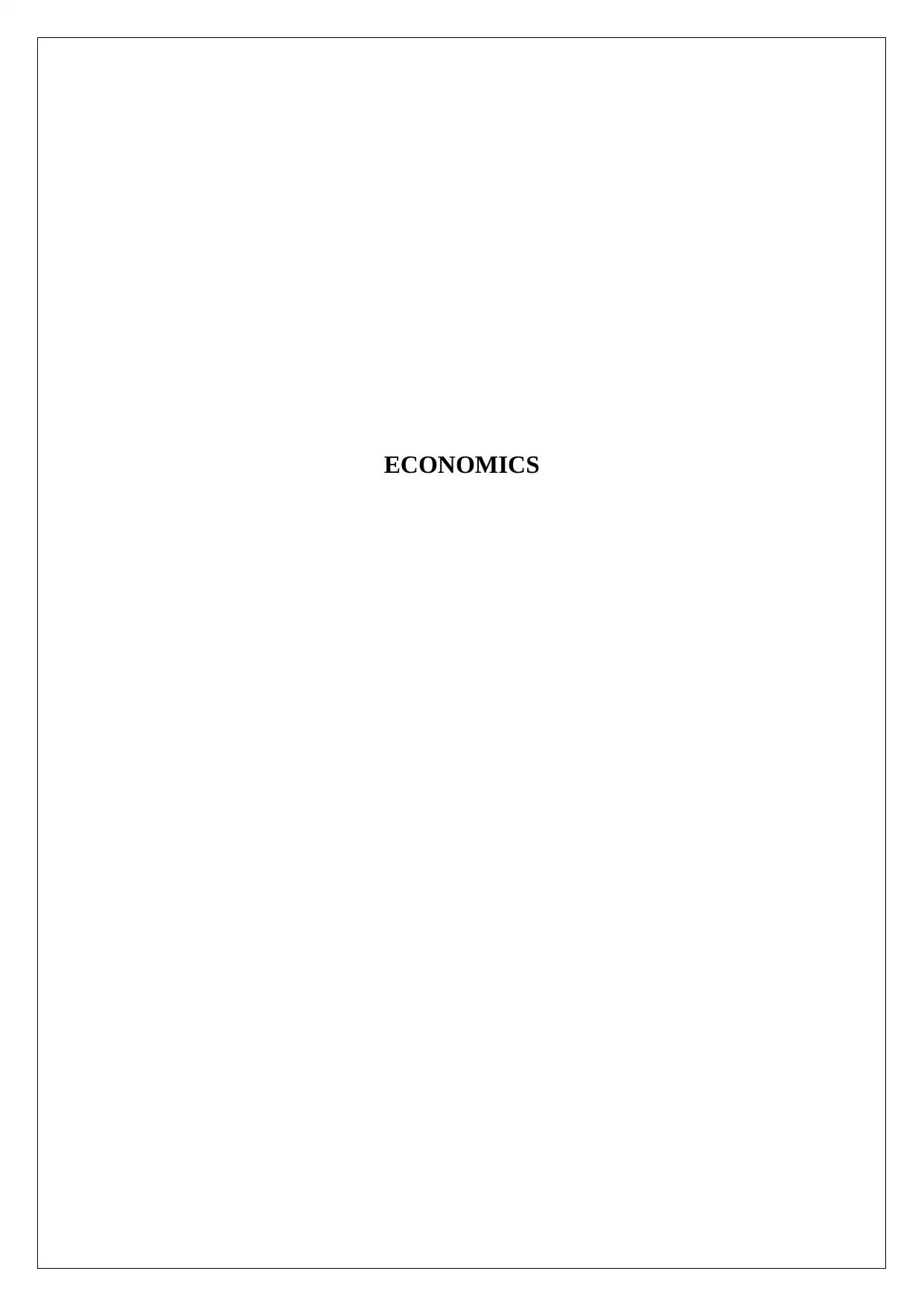
ECONOMICS
Paraphrase This Document
Need a fresh take? Get an instant paraphrase of this document with our AI Paraphraser
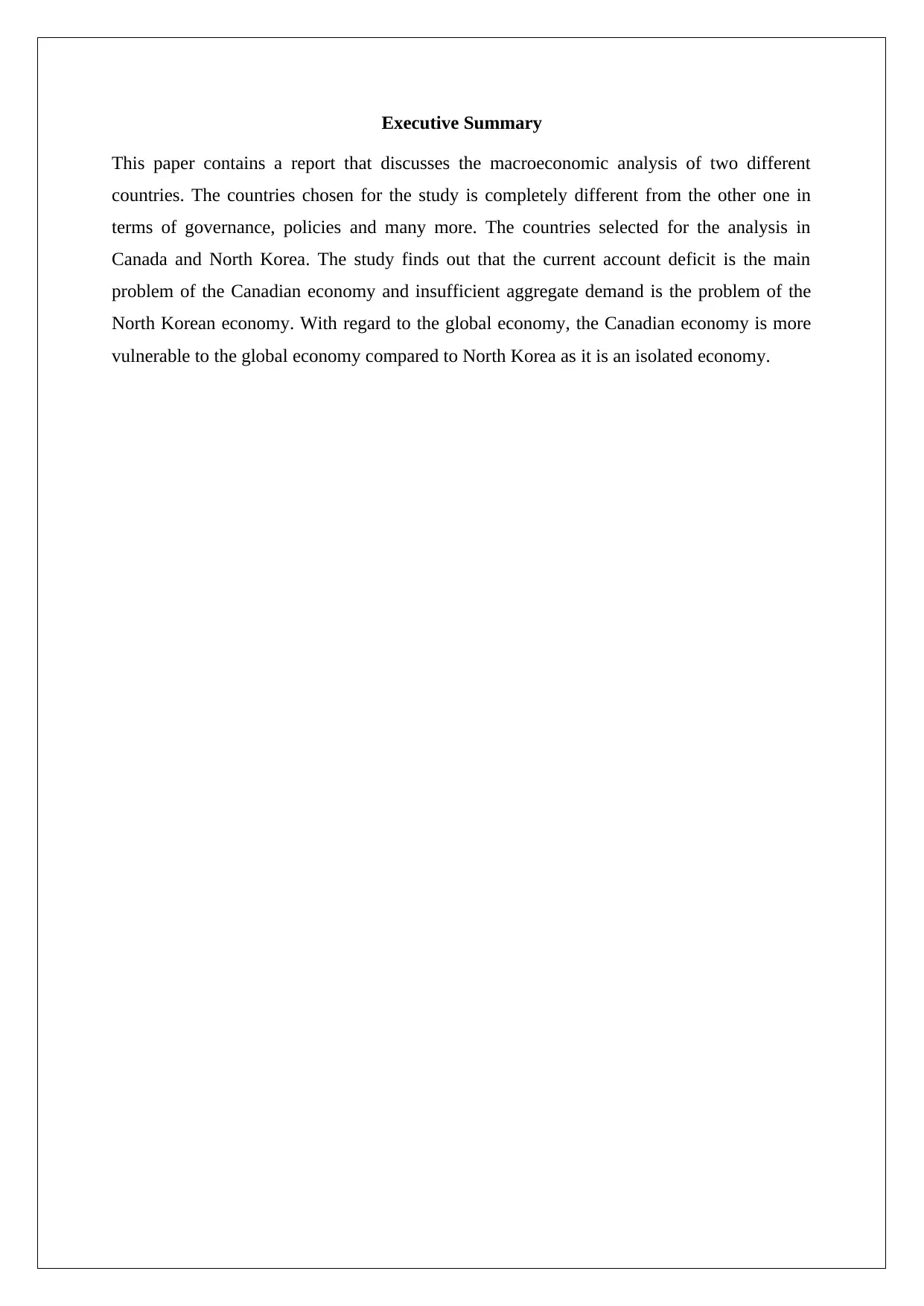
Executive Summary
This paper contains a report that discusses the macroeconomic analysis of two different
countries. The countries chosen for the study is completely different from the other one in
terms of governance, policies and many more. The countries selected for the analysis in
Canada and North Korea. The study finds out that the current account deficit is the main
problem of the Canadian economy and insufficient aggregate demand is the problem of the
North Korean economy. With regard to the global economy, the Canadian economy is more
vulnerable to the global economy compared to North Korea as it is an isolated economy.
This paper contains a report that discusses the macroeconomic analysis of two different
countries. The countries chosen for the study is completely different from the other one in
terms of governance, policies and many more. The countries selected for the analysis in
Canada and North Korea. The study finds out that the current account deficit is the main
problem of the Canadian economy and insufficient aggregate demand is the problem of the
North Korean economy. With regard to the global economy, the Canadian economy is more
vulnerable to the global economy compared to North Korea as it is an isolated economy.
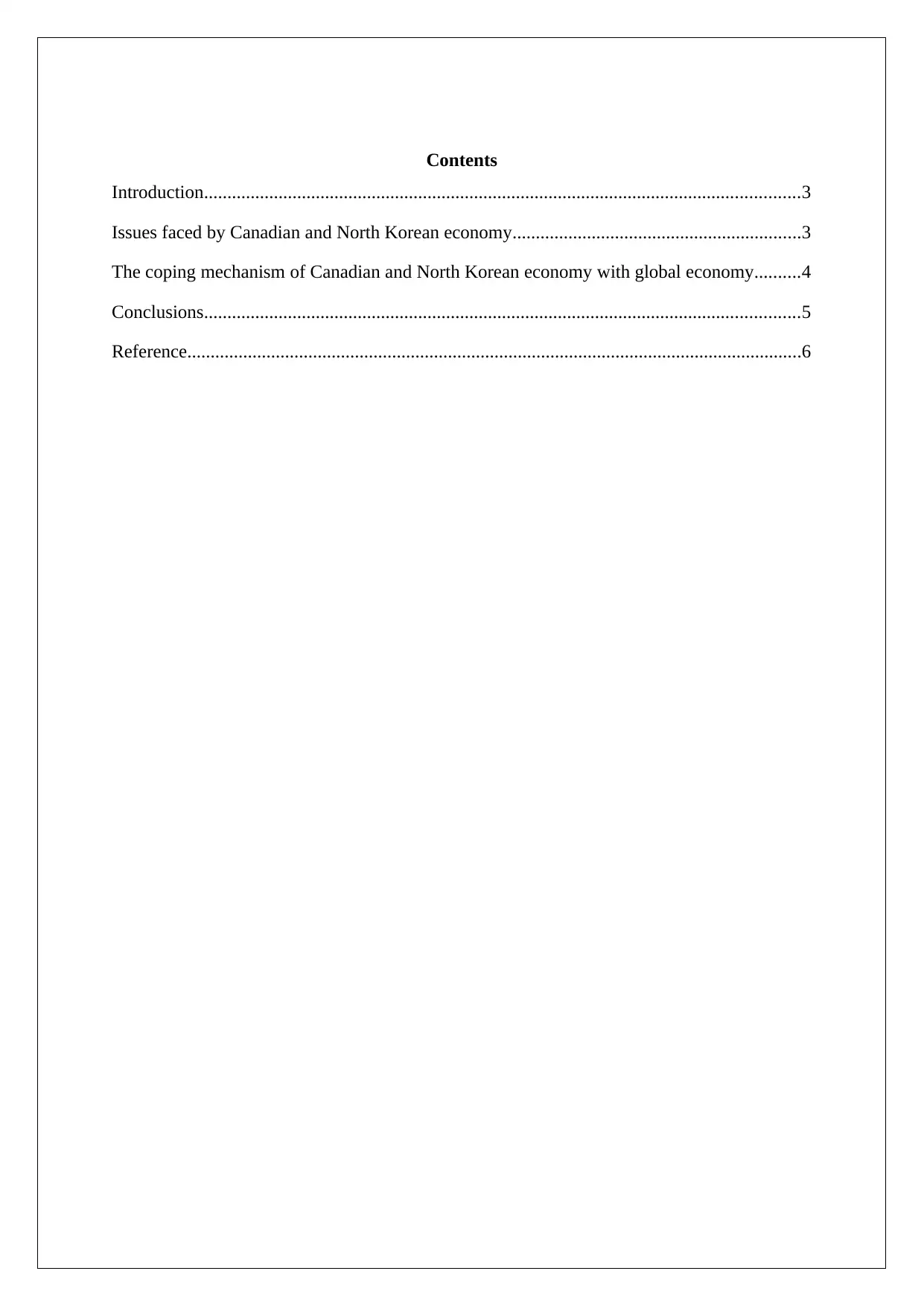
Contents
Introduction................................................................................................................................3
Issues faced by Canadian and North Korean economy..............................................................3
The coping mechanism of Canadian and North Korean economy with global economy..........4
Conclusions................................................................................................................................5
Reference....................................................................................................................................6
Introduction................................................................................................................................3
Issues faced by Canadian and North Korean economy..............................................................3
The coping mechanism of Canadian and North Korean economy with global economy..........4
Conclusions................................................................................................................................5
Reference....................................................................................................................................6
⊘ This is a preview!⊘
Do you want full access?
Subscribe today to unlock all pages.

Trusted by 1+ million students worldwide
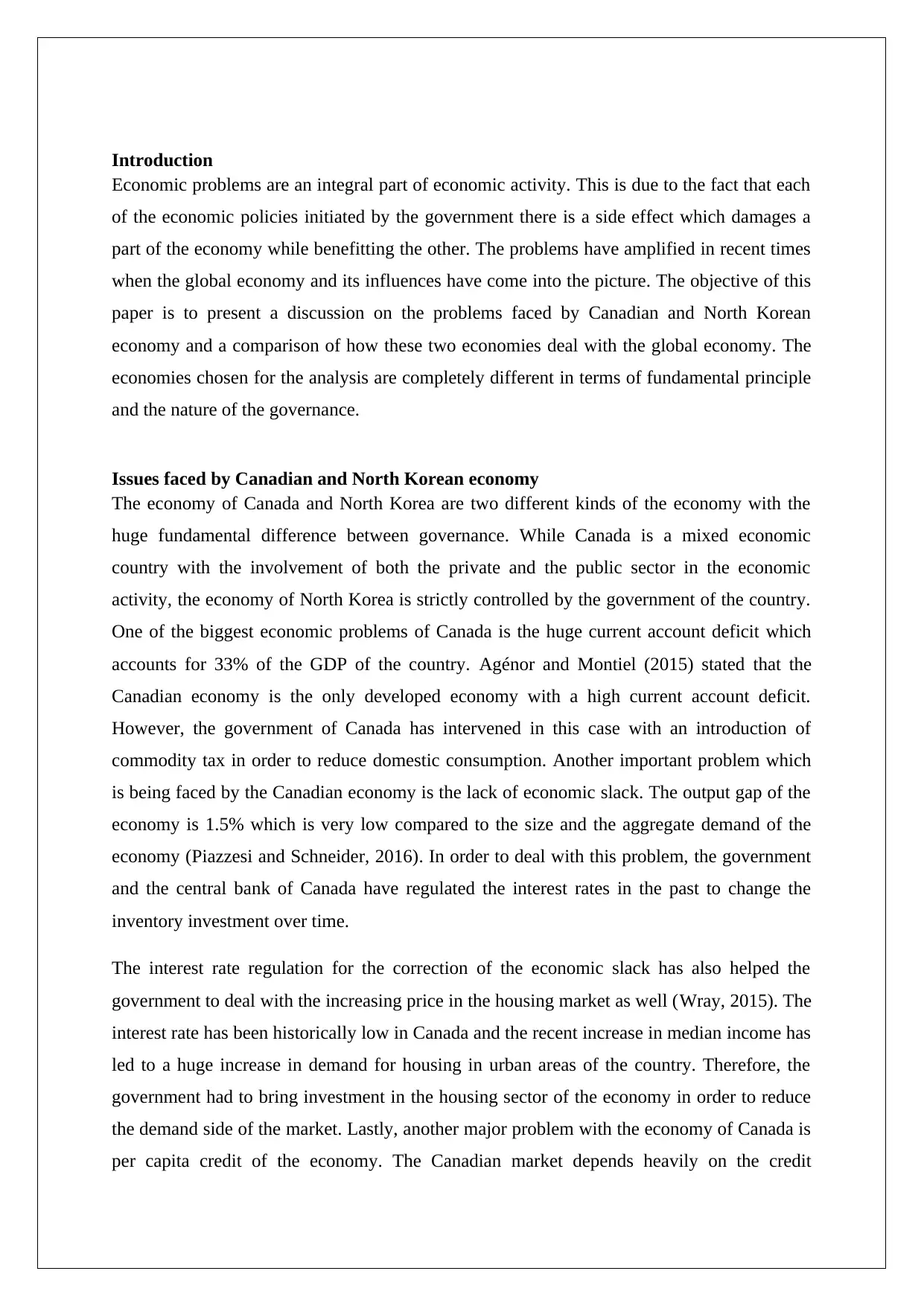
Introduction
Economic problems are an integral part of economic activity. This is due to the fact that each
of the economic policies initiated by the government there is a side effect which damages a
part of the economy while benefitting the other. The problems have amplified in recent times
when the global economy and its influences have come into the picture. The objective of this
paper is to present a discussion on the problems faced by Canadian and North Korean
economy and a comparison of how these two economies deal with the global economy. The
economies chosen for the analysis are completely different in terms of fundamental principle
and the nature of the governance.
Issues faced by Canadian and North Korean economy
The economy of Canada and North Korea are two different kinds of the economy with the
huge fundamental difference between governance. While Canada is a mixed economic
country with the involvement of both the private and the public sector in the economic
activity, the economy of North Korea is strictly controlled by the government of the country.
One of the biggest economic problems of Canada is the huge current account deficit which
accounts for 33% of the GDP of the country. Agénor and Montiel (2015) stated that the
Canadian economy is the only developed economy with a high current account deficit.
However, the government of Canada has intervened in this case with an introduction of
commodity tax in order to reduce domestic consumption. Another important problem which
is being faced by the Canadian economy is the lack of economic slack. The output gap of the
economy is 1.5% which is very low compared to the size and the aggregate demand of the
economy (Piazzesi and Schneider, 2016). In order to deal with this problem, the government
and the central bank of Canada have regulated the interest rates in the past to change the
inventory investment over time.
The interest rate regulation for the correction of the economic slack has also helped the
government to deal with the increasing price in the housing market as well (Wray, 2015). The
interest rate has been historically low in Canada and the recent increase in median income has
led to a huge increase in demand for housing in urban areas of the country. Therefore, the
government had to bring investment in the housing sector of the economy in order to reduce
the demand side of the market. Lastly, another major problem with the economy of Canada is
per capita credit of the economy. The Canadian market depends heavily on the credit
Economic problems are an integral part of economic activity. This is due to the fact that each
of the economic policies initiated by the government there is a side effect which damages a
part of the economy while benefitting the other. The problems have amplified in recent times
when the global economy and its influences have come into the picture. The objective of this
paper is to present a discussion on the problems faced by Canadian and North Korean
economy and a comparison of how these two economies deal with the global economy. The
economies chosen for the analysis are completely different in terms of fundamental principle
and the nature of the governance.
Issues faced by Canadian and North Korean economy
The economy of Canada and North Korea are two different kinds of the economy with the
huge fundamental difference between governance. While Canada is a mixed economic
country with the involvement of both the private and the public sector in the economic
activity, the economy of North Korea is strictly controlled by the government of the country.
One of the biggest economic problems of Canada is the huge current account deficit which
accounts for 33% of the GDP of the country. Agénor and Montiel (2015) stated that the
Canadian economy is the only developed economy with a high current account deficit.
However, the government of Canada has intervened in this case with an introduction of
commodity tax in order to reduce domestic consumption. Another important problem which
is being faced by the Canadian economy is the lack of economic slack. The output gap of the
economy is 1.5% which is very low compared to the size and the aggregate demand of the
economy (Piazzesi and Schneider, 2016). In order to deal with this problem, the government
and the central bank of Canada have regulated the interest rates in the past to change the
inventory investment over time.
The interest rate regulation for the correction of the economic slack has also helped the
government to deal with the increasing price in the housing market as well (Wray, 2015). The
interest rate has been historically low in Canada and the recent increase in median income has
led to a huge increase in demand for housing in urban areas of the country. Therefore, the
government had to bring investment in the housing sector of the economy in order to reduce
the demand side of the market. Lastly, another major problem with the economy of Canada is
per capita credit of the economy. The Canadian market depends heavily on the credit
Paraphrase This Document
Need a fresh take? Get an instant paraphrase of this document with our AI Paraphraser
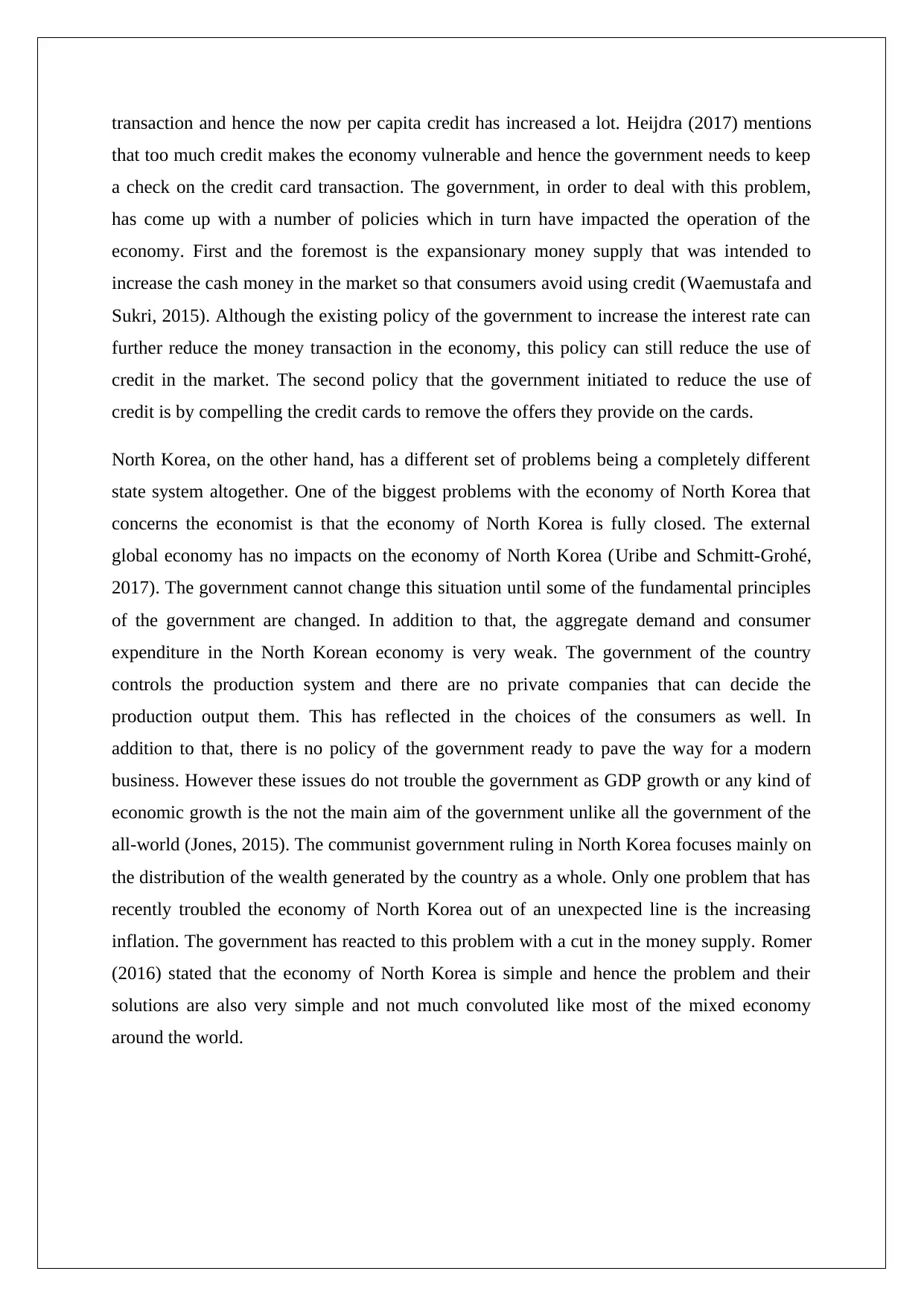
transaction and hence the now per capita credit has increased a lot. Heijdra (2017) mentions
that too much credit makes the economy vulnerable and hence the government needs to keep
a check on the credit card transaction. The government, in order to deal with this problem,
has come up with a number of policies which in turn have impacted the operation of the
economy. First and the foremost is the expansionary money supply that was intended to
increase the cash money in the market so that consumers avoid using credit (Waemustafa and
Sukri, 2015). Although the existing policy of the government to increase the interest rate can
further reduce the money transaction in the economy, this policy can still reduce the use of
credit in the market. The second policy that the government initiated to reduce the use of
credit is by compelling the credit cards to remove the offers they provide on the cards.
North Korea, on the other hand, has a different set of problems being a completely different
state system altogether. One of the biggest problems with the economy of North Korea that
concerns the economist is that the economy of North Korea is fully closed. The external
global economy has no impacts on the economy of North Korea (Uribe and Schmitt-Grohé,
2017). The government cannot change this situation until some of the fundamental principles
of the government are changed. In addition to that, the aggregate demand and consumer
expenditure in the North Korean economy is very weak. The government of the country
controls the production system and there are no private companies that can decide the
production output them. This has reflected in the choices of the consumers as well. In
addition to that, there is no policy of the government ready to pave the way for a modern
business. However these issues do not trouble the government as GDP growth or any kind of
economic growth is the not the main aim of the government unlike all the government of the
all-world (Jones, 2015). The communist government ruling in North Korea focuses mainly on
the distribution of the wealth generated by the country as a whole. Only one problem that has
recently troubled the economy of North Korea out of an unexpected line is the increasing
inflation. The government has reacted to this problem with a cut in the money supply. Romer
(2016) stated that the economy of North Korea is simple and hence the problem and their
solutions are also very simple and not much convoluted like most of the mixed economy
around the world.
that too much credit makes the economy vulnerable and hence the government needs to keep
a check on the credit card transaction. The government, in order to deal with this problem,
has come up with a number of policies which in turn have impacted the operation of the
economy. First and the foremost is the expansionary money supply that was intended to
increase the cash money in the market so that consumers avoid using credit (Waemustafa and
Sukri, 2015). Although the existing policy of the government to increase the interest rate can
further reduce the money transaction in the economy, this policy can still reduce the use of
credit in the market. The second policy that the government initiated to reduce the use of
credit is by compelling the credit cards to remove the offers they provide on the cards.
North Korea, on the other hand, has a different set of problems being a completely different
state system altogether. One of the biggest problems with the economy of North Korea that
concerns the economist is that the economy of North Korea is fully closed. The external
global economy has no impacts on the economy of North Korea (Uribe and Schmitt-Grohé,
2017). The government cannot change this situation until some of the fundamental principles
of the government are changed. In addition to that, the aggregate demand and consumer
expenditure in the North Korean economy is very weak. The government of the country
controls the production system and there are no private companies that can decide the
production output them. This has reflected in the choices of the consumers as well. In
addition to that, there is no policy of the government ready to pave the way for a modern
business. However these issues do not trouble the government as GDP growth or any kind of
economic growth is the not the main aim of the government unlike all the government of the
all-world (Jones, 2015). The communist government ruling in North Korea focuses mainly on
the distribution of the wealth generated by the country as a whole. Only one problem that has
recently troubled the economy of North Korea out of an unexpected line is the increasing
inflation. The government has reacted to this problem with a cut in the money supply. Romer
(2016) stated that the economy of North Korea is simple and hence the problem and their
solutions are also very simple and not much convoluted like most of the mixed economy
around the world.
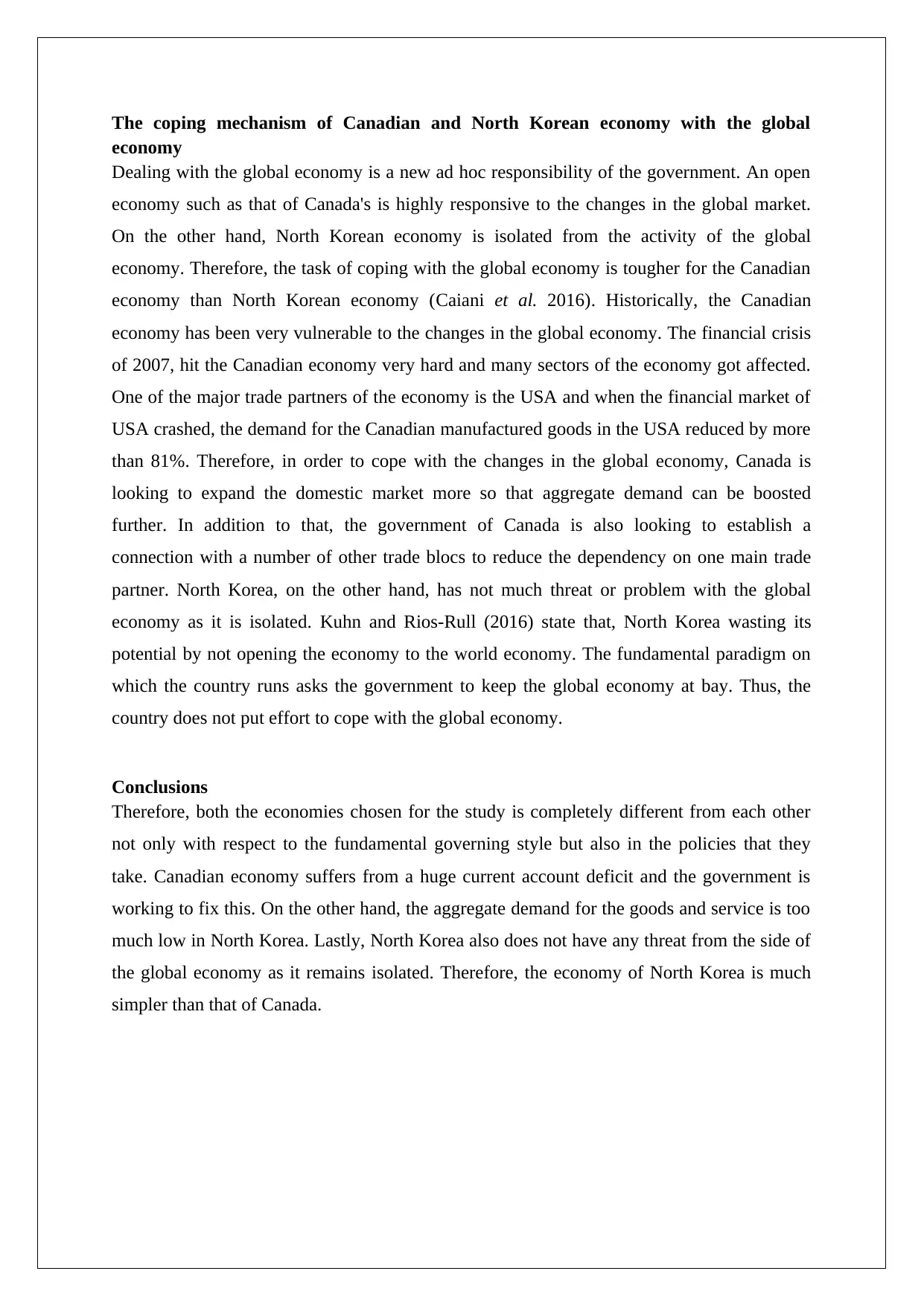
The coping mechanism of Canadian and North Korean economy with the global
economy
Dealing with the global economy is a new ad hoc responsibility of the government. An open
economy such as that of Canada's is highly responsive to the changes in the global market.
On the other hand, North Korean economy is isolated from the activity of the global
economy. Therefore, the task of coping with the global economy is tougher for the Canadian
economy than North Korean economy (Caiani et al. 2016). Historically, the Canadian
economy has been very vulnerable to the changes in the global economy. The financial crisis
of 2007, hit the Canadian economy very hard and many sectors of the economy got affected.
One of the major trade partners of the economy is the USA and when the financial market of
USA crashed, the demand for the Canadian manufactured goods in the USA reduced by more
than 81%. Therefore, in order to cope with the changes in the global economy, Canada is
looking to expand the domestic market more so that aggregate demand can be boosted
further. In addition to that, the government of Canada is also looking to establish a
connection with a number of other trade blocs to reduce the dependency on one main trade
partner. North Korea, on the other hand, has not much threat or problem with the global
economy as it is isolated. Kuhn and Rios-Rull (2016) state that, North Korea wasting its
potential by not opening the economy to the world economy. The fundamental paradigm on
which the country runs asks the government to keep the global economy at bay. Thus, the
country does not put effort to cope with the global economy.
Conclusions
Therefore, both the economies chosen for the study is completely different from each other
not only with respect to the fundamental governing style but also in the policies that they
take. Canadian economy suffers from a huge current account deficit and the government is
working to fix this. On the other hand, the aggregate demand for the goods and service is too
much low in North Korea. Lastly, North Korea also does not have any threat from the side of
the global economy as it remains isolated. Therefore, the economy of North Korea is much
simpler than that of Canada.
economy
Dealing with the global economy is a new ad hoc responsibility of the government. An open
economy such as that of Canada's is highly responsive to the changes in the global market.
On the other hand, North Korean economy is isolated from the activity of the global
economy. Therefore, the task of coping with the global economy is tougher for the Canadian
economy than North Korean economy (Caiani et al. 2016). Historically, the Canadian
economy has been very vulnerable to the changes in the global economy. The financial crisis
of 2007, hit the Canadian economy very hard and many sectors of the economy got affected.
One of the major trade partners of the economy is the USA and when the financial market of
USA crashed, the demand for the Canadian manufactured goods in the USA reduced by more
than 81%. Therefore, in order to cope with the changes in the global economy, Canada is
looking to expand the domestic market more so that aggregate demand can be boosted
further. In addition to that, the government of Canada is also looking to establish a
connection with a number of other trade blocs to reduce the dependency on one main trade
partner. North Korea, on the other hand, has not much threat or problem with the global
economy as it is isolated. Kuhn and Rios-Rull (2016) state that, North Korea wasting its
potential by not opening the economy to the world economy. The fundamental paradigm on
which the country runs asks the government to keep the global economy at bay. Thus, the
country does not put effort to cope with the global economy.
Conclusions
Therefore, both the economies chosen for the study is completely different from each other
not only with respect to the fundamental governing style but also in the policies that they
take. Canadian economy suffers from a huge current account deficit and the government is
working to fix this. On the other hand, the aggregate demand for the goods and service is too
much low in North Korea. Lastly, North Korea also does not have any threat from the side of
the global economy as it remains isolated. Therefore, the economy of North Korea is much
simpler than that of Canada.
⊘ This is a preview!⊘
Do you want full access?
Subscribe today to unlock all pages.

Trusted by 1+ million students worldwide
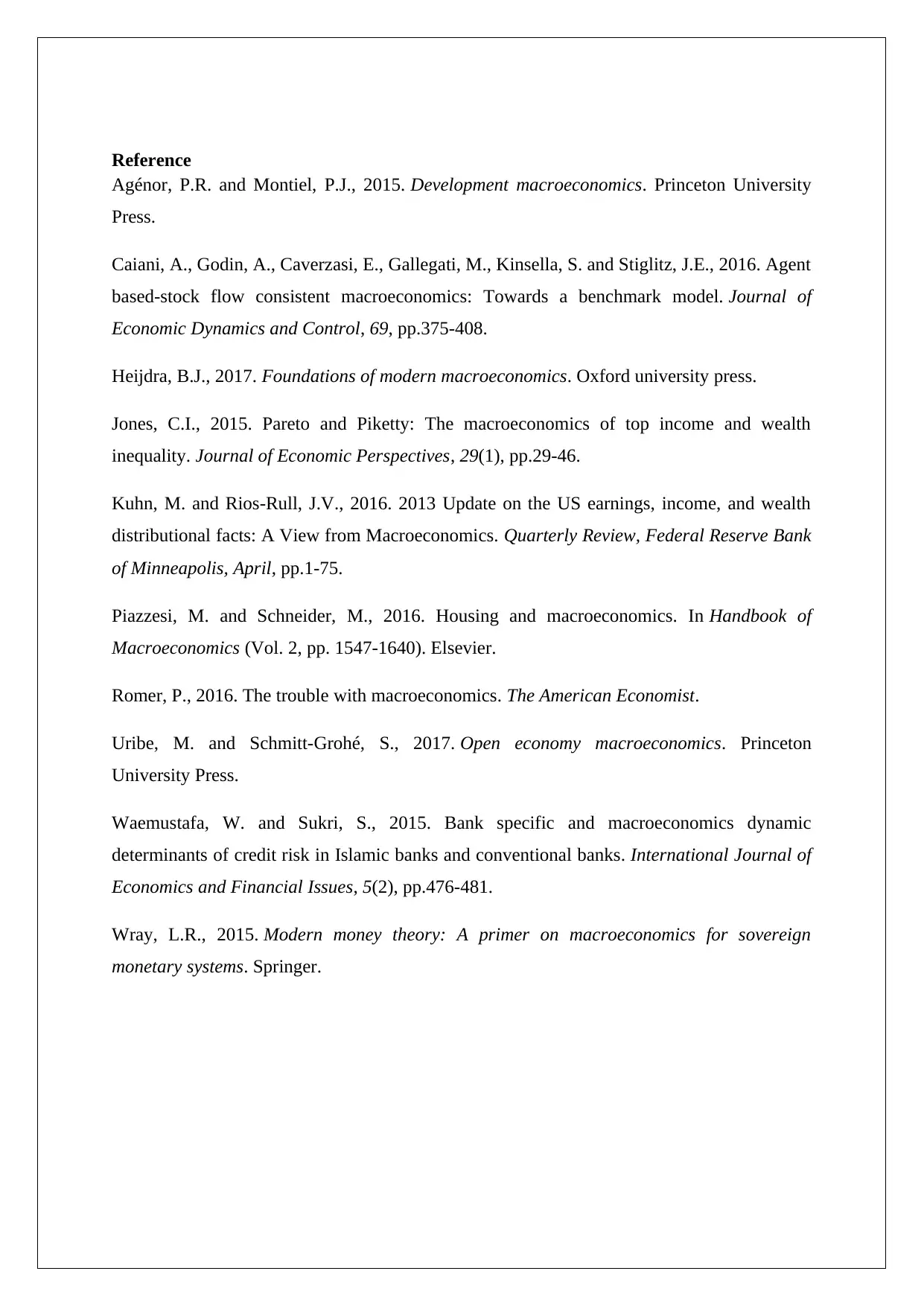
Reference
Agénor, P.R. and Montiel, P.J., 2015. Development macroeconomics. Princeton University
Press.
Caiani, A., Godin, A., Caverzasi, E., Gallegati, M., Kinsella, S. and Stiglitz, J.E., 2016. Agent
based-stock flow consistent macroeconomics: Towards a benchmark model. Journal of
Economic Dynamics and Control, 69, pp.375-408.
Heijdra, B.J., 2017. Foundations of modern macroeconomics. Oxford university press.
Jones, C.I., 2015. Pareto and Piketty: The macroeconomics of top income and wealth
inequality. Journal of Economic Perspectives, 29(1), pp.29-46.
Kuhn, M. and Rios-Rull, J.V., 2016. 2013 Update on the US earnings, income, and wealth
distributional facts: A View from Macroeconomics. Quarterly Review, Federal Reserve Bank
of Minneapolis, April, pp.1-75.
Piazzesi, M. and Schneider, M., 2016. Housing and macroeconomics. In Handbook of
Macroeconomics (Vol. 2, pp. 1547-1640). Elsevier.
Romer, P., 2016. The trouble with macroeconomics. The American Economist.
Uribe, M. and Schmitt-Grohé, S., 2017. Open economy macroeconomics. Princeton
University Press.
Waemustafa, W. and Sukri, S., 2015. Bank specific and macroeconomics dynamic
determinants of credit risk in Islamic banks and conventional banks. International Journal of
Economics and Financial Issues, 5(2), pp.476-481.
Wray, L.R., 2015. Modern money theory: A primer on macroeconomics for sovereign
monetary systems. Springer.
Agénor, P.R. and Montiel, P.J., 2015. Development macroeconomics. Princeton University
Press.
Caiani, A., Godin, A., Caverzasi, E., Gallegati, M., Kinsella, S. and Stiglitz, J.E., 2016. Agent
based-stock flow consistent macroeconomics: Towards a benchmark model. Journal of
Economic Dynamics and Control, 69, pp.375-408.
Heijdra, B.J., 2017. Foundations of modern macroeconomics. Oxford university press.
Jones, C.I., 2015. Pareto and Piketty: The macroeconomics of top income and wealth
inequality. Journal of Economic Perspectives, 29(1), pp.29-46.
Kuhn, M. and Rios-Rull, J.V., 2016. 2013 Update on the US earnings, income, and wealth
distributional facts: A View from Macroeconomics. Quarterly Review, Federal Reserve Bank
of Minneapolis, April, pp.1-75.
Piazzesi, M. and Schneider, M., 2016. Housing and macroeconomics. In Handbook of
Macroeconomics (Vol. 2, pp. 1547-1640). Elsevier.
Romer, P., 2016. The trouble with macroeconomics. The American Economist.
Uribe, M. and Schmitt-Grohé, S., 2017. Open economy macroeconomics. Princeton
University Press.
Waemustafa, W. and Sukri, S., 2015. Bank specific and macroeconomics dynamic
determinants of credit risk in Islamic banks and conventional banks. International Journal of
Economics and Financial Issues, 5(2), pp.476-481.
Wray, L.R., 2015. Modern money theory: A primer on macroeconomics for sovereign
monetary systems. Springer.
1 out of 7
Related Documents
Your All-in-One AI-Powered Toolkit for Academic Success.
+13062052269
info@desklib.com
Available 24*7 on WhatsApp / Email
![[object Object]](/_next/static/media/star-bottom.7253800d.svg)
Unlock your academic potential
Copyright © 2020–2025 A2Z Services. All Rights Reserved. Developed and managed by ZUCOL.





